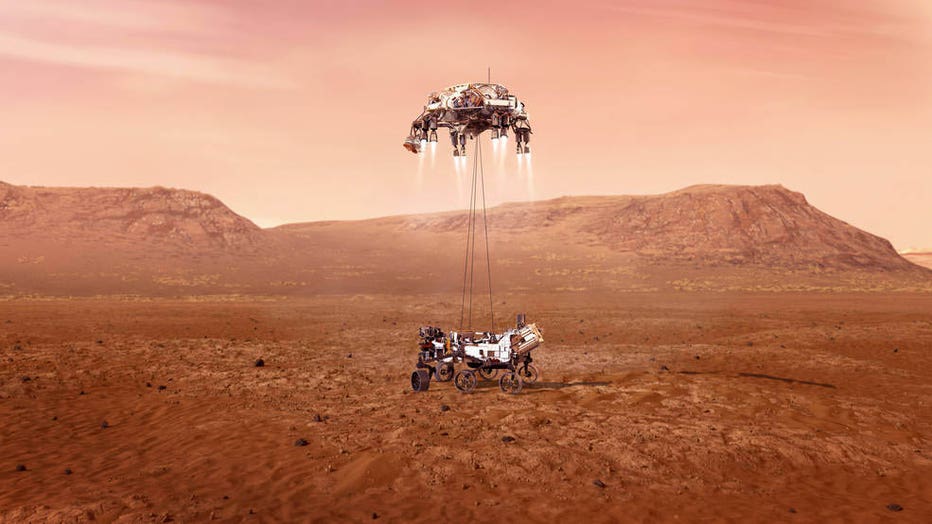NASA's Perseverance rover lands on Mars to look for signs of ancient life
PASADENA, Calif. - NASA’s Perseverance rover, the biggest, most advanced rover to date, has landed on Mars in a mission to search for signs of ancient life on the red planet.
Ground controllers at the space agency’s Jet Propulsion Laboratory in Pasadena, California, cheered and exchanged fist bumps and high-fives in triumph — and relief — on receiving confirmation that the six-wheeled Perseverance had touched down on the red planet, long a deathtrap for incoming spacecraft.
Hundreds of critical events had to be executed perfectly and exactly on time for the rover to land safely. It took a tension-filled 11 1/2 minutes for the signal to reach Earth.
"Touchdown confirmed! Perseverance safely on the surface of Mars," flight controller Swati Mohan announced.

The first image sent from NASA’s Perseverance rover on the surface of Mars. (Photo credit: NASA/JPL-Caltech)
Percy, as it is nicknamed, lifted off in July to take advantage of the close alignment of Earth and Mars, traveling some 300 million miles in nearly seven months. The rover stood became the ninth spacecraft to successfully land on Mars, every one of them from the U.S., beginning in the 1970s.
The car-size, plutonium-powered vehicle arrived at Jezero Crater, hitting NASA’s smallest and trickiest target yet: a 5-by-4 mile strip on an ancient river delta full of pits, cliffs and fields of rock. Scientists believe that if life ever flourished on Mars, it would have happened 3 billion to 4 billion years ago, when water still flowed on the planet.
Over the next two years, the six-wheeled vehicle will use its 7-foot arm to drill down and collect rock samples with possible signs of bygone microscopic life. Three to four dozen chalk-size samples will be sealed in tubes and set aside on Mars to be retrieved by a fetch rover and brought homeward by another rocket ship. The goal is to get them back to Earth as early as 2031.
Scientists hope to answer one of the central questions of theology, philosophy and space exploration.
"Are we alone in this sort of vast cosmic desert, just flying through space, or is life much more common? Does it just emerge whenever and wherever the conditions are ripe?" said deputy project scientist Ken Williford. "We’re really on the verge of being able to potentially answer these enormous questions."

An illustration of NASA’s Perseverance rover landing safely on Mars. Hundreds of critical events must execute perfectly and exactly on time for the rover to land safely on Feb. 18, 2021. (Photo credit: NASA/JPL-Caltech)
Perseverance's descent had been described by NASA as "seven minutes of terror." Flight controllers waited helplessly as the preprogrammed spacecraft hit the thin, 95% carbon dioxide Martian atmosphere at 12,100 mph, or 16 times the speed of sound, slowing as it plummeted.
It released its 70-foot parachute, jettisoned its heat shield, and then used a rocket-steered platform known as a sky crane to lower the rover the final 60 or so feet to the surface.
The rover, which has its own Facebook and Twitter accounts to follow along on its journey, shared the first image from its "forever home."
Its landing marked the third visit to Mars in just over a week, as two spacecraft from the United Arab Emirates and China swung into orbit around the planet on successive days last week.
China’s spacecraft includes a smaller rover that also will be seeking evidence of life — if it makes it safely down from orbit in May or June.
RELATED: China's Tianwen-1 spacecraft enters Mars' orbit one day after Arab ship arrives
NASA’s mission control team had invited the world to tune in, providing landing coverage and confirmation of the rover’s landing. It is also offered a Spanish language show for the landing — the agency’s first.
This story was reported from Cincinnati. The Associated Press contributed.

